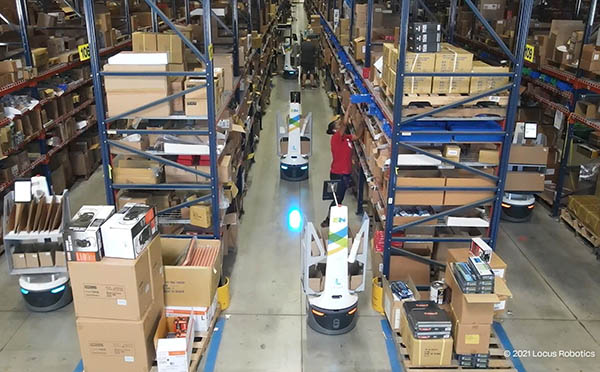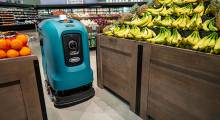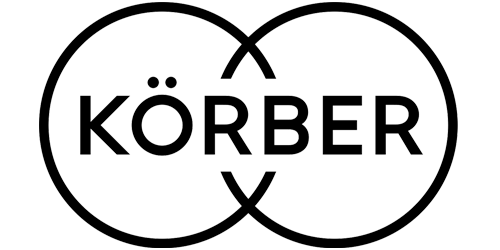The meteoric rise of e-commerce has continued to challenge supply chains to keep prices low while also meeting consumer expectations of same-day or next-day delivery. Warehouse operators are increasingly investing in automation—specifically, autonomous mobile robots or AMRs.
Global e-commerce sales have increased 26.7% year over year, from $3.3 trillion in 2019 to $4.8 trillion in 2021, according to market observers. In addition, growing numbers of SKUs, constant demand and more drastic peaks, and ongoing labor shortages require retailers and distribution centers (DCs) to keep up with expectations and competitors such as Amazon.
Mobile robots are revolutionizing manufacturing and logistics, enabling faster order fulfillment, increasing efficiency, and lowering labor costs. AMRs use sensors and cameras to build digital maps of their environments and include safety mechanisms to move around warehouses guidance-free. (This is different from the previous generation of automated guided vehicles, or AGVs, which required more infrastructure.)
Let’s take a look at some use cases for deploying AMRs in the warehouse, along with the benefits that automation can bring to your supply chain.
AMRs can increase pick rates, decrease labor costs
Evo, a brand of Seattle-based Evolucion Innovations Inc., is a leading online retailer of sports gear and apparel. It invested in AMRs to help meet 2020 holiday peak challenges. Before the technology investment, employees picked about 35 units per hour (UPH).
After adding robots from Locus Robotics, that number increased to 90 UPH on average and enabled productivity to increase by 40% during peak season. This allowed evo to use fewer staffers and enabled workers to remain socially distant before the COVID-19 vaccine was widely available.
In this case, evo wanted to scale quickly without reconfiguring its warehouse, so AMRs were the best solution (see video below).
In many areas of the world, including the U.S. and Europe, warehouses had difficulty attracting and retaining employees long before the pandemic, particularly in the cold storage industry. In other areas of the world – namely the Asia-Pacific region – an adequate pool of workers exists, but labor costs are exorbitantly high, and so is real estate.
In fact, Körber Supply Chain has a client in the Philippines, BigBlue Logistics Corp., which uses 250 goods-to-person and sortation AMRs in its three-level mezzanine warehouse to help offset high labor costs and fulfill orders quickly.
How to redeploy your workforce and improve throughput
Interestingly, most companies investing in mobile robots don’t necessarily use them to cut labor. AMRs can take over time-consuming, repetitive tasks, enabling operations to redeploy workers elsewhere in the warehouse.
AMRs and people can move and work together on the warehouse floor. In goods-to-person automation, robots brings the products or units to the employees. They also handle bulk material movement, component shuttling, piece picking, pallet picking, and sortation.
In addition, AMRs can complement other warehouse technology such as voice-directed work and conveyors. They offer several benefits, including:
- Enhanced efficiency – Workers can pick more frequently and have the ability to fulfill multiple orders simultaneously.
- Increased capacity – Automating low-value tasks like pushing items around enables workers to perform higher-value activities.
- Improved productivity – Faster turnabout, including processing more picks, leads to better throughput and increased revenue.
- Reduced errors – Robots can give each worker information about an item to pick, such as where it’s found, where to drop it, and what it looks like, decreasing the likelihood of selecting the wrong product.
- Easy integration – These smart robots, which learn from their surroundings and adapt movements accordingly, are simple for suppliers or integrators to add to existing operations with minimal disruptions or modifications.
- Lowered costs – AMRs are far more affordable than traditional automation and can help mitigate labor expenses.
And since AMRs are scalable, they can adjust to each business' needs and warehouse environment. They can become permanent fixtures or rolled out when needed and stored when not in use.
Choose a provider that will improve workflow
Increasingly, Körber has found that prospective customers are interested not only in autonomous mobile robots, but also in finding technology providers that understand the workflow of a warehouse or DC.
Before selecting a solution, the provider should provide answers about picking workflow, receiving goods processes, replenishing the grid, consolidating orders, taking products to the next station, and so on.
Remember, when investing in AMRs or any automation, it’s more than just a robot deployment. It’s a workflow deployment. As such, make sure you choose a technology provider that well-versed and experienced in AMRs, as well as in designing an entire warehouse or DC – everything from inbound right through to outbound. You should consider partnering with a provider interested in helping you plan for an AMR-enabled warehouse or DC.

About the author
Nishan Wijemanne is managing director for Asia-Pacific at Körber Supply Chain Software and global leader for AMRs. He leads and drives the growth and success of voice, vision, mobility, robotics, and software competencies at Körber for the region while spearheading the strategic growth for AMR excellence across the globe.
Article topics
Email Sign Up




















